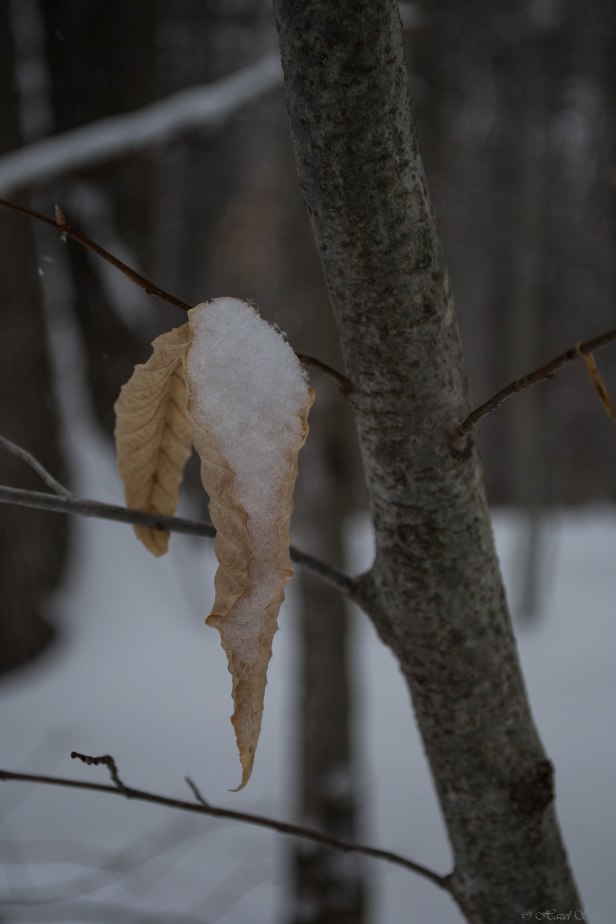American Beech, Fagus grandifolia
Family: Fagaceae, the Beech Family
Description: Native deciduous tree. Coarsely serrate leaves often persistent through winter, smooth gray bark, sharply pointed slender buds, two triangular nuts found within prickly, hardened involucres.
Abundance: Common
Habitat: In the North, beech is found in low elevations and is a dominant or codominant species of the northern hardwoods.
Plant Parts Used: Nuts, bark, leaves
Medicine: Skin irritation, expelling worms
Food: Edible nuts The edible nuts are a favorite food for Eastern Black Bears, but humans can enjoy them too.
Unfortunately, most beech trees in this region are affected by the beech bark disease, giving the usually smooth, gray bark an uncharacteristic warty texture. Deb told me a fond memory of a year when beech nuts were especially plentiful and she enjoyed an apple pie sprinkled with these tasty nuts. John says the edible nuts also help with expelling worms, a method the Cherokee employed as well. A poultice made out of the leaves or bark can help treat skin irritation. The Malecite and Potawatomi used the leaves as a dermatological aid, for sores and burns respectively. The Rappahannock used a wash of the leaves for poison ivy rashes.
Caution: Beech nuts must be cooked because the raw seed kernels contain some toxic compounds. According to Turner and Von Aderkas, if a person consumed fifty or more of the raw nuts in one sitting, he or she might experience “headache, abdominal pain, vomiting, diarrhea, and extreme fatigue” for one to five hours.
Note: This post is part of my Plants and People series. See my Plants and People page for more information about the project and the people referenced in this post.
References:
- Brooks, John. Personal Interview. 28 Nov. 2010.
- “Fagus Grandifolia.” US Forest Service – Caring for the Land and Serving People. 11 Apr. 2011. <http://www.fs.fed.us/database/feis/plants/tree/faggra/all.html>.
- Hayes, Terry-Anya. Personal interview. 27 Oct. 2010.
- Michener, Martin C. Botany Everywhere: Woods, Field, Home, and Garden Plants of NE USA, Third Edition. Hollis, NH: MIST Software Associates, Inc., 2009. PDF.
- Mittelhauser, Glen H., Linda L. Gregory, Sally C. Rooney, and Jill E. Weber. The Plants of Acadia National Park. Orono, Me.: University of Maine, 2010. Print.
- Moerman, Daniel E. Native American Medicinal Plants: an Ethnobotanical Dictionary. Portland, Or.: Timber, 2009. Print.
- Reitze, Raymond and Nancy. Personal interview. 8, 15 Oct. 2010.
- Soule, Deb. Personal interview. 4 Feb. 2011.
- Szwed, Sue. Personal interview. 12 Nov. 2010.
- Turner, Nancy J., and Patrick Von Aderkas. The North American Guide to Common Poisonous Plants and Mushrooms. Portland: Timber, 2009. Print.



Sorry, didin’t know about the bark disease. Sad. Does it kill the tree? We have aspens here. They remind me of the beeches back east because of the bark color. We have a lot of beetles and bud worms that kill a lot of trees around here. A few years ago we had a pinon disease go through that killed 90% of the pinons. Their immune systems were do low because of the drought. Anyway – thanks for beech info. May they happily get through this bark problem.
We also have aspens here; I think they look most like birch trees, though they all do have that smooth bark in common. The blight does eventually kill beech trees, so our forests will likely be in for a major change in the coming years.
I like your detached way of seeing the forests change – and I mean that as a compassionate loving, as opposed to a sentimental loving way. I get sad when I experience loss. You see it as a natural process. I want to be more like that. It is a way that is more open to new possibilities and an “okness” with what is, instead of attachment to the old.
Change is the only constant, after all! It’s hard for me to adjust to change in my backyard, for sure, but when I step back and think about the geologic timescale and the waves of changes in the forest that are constantly occurring, it helps ground me.
Yes, thank you for reminding me of the big picture.